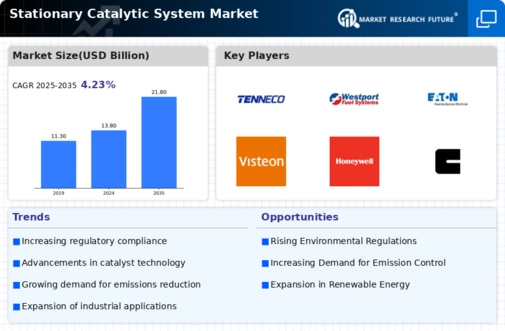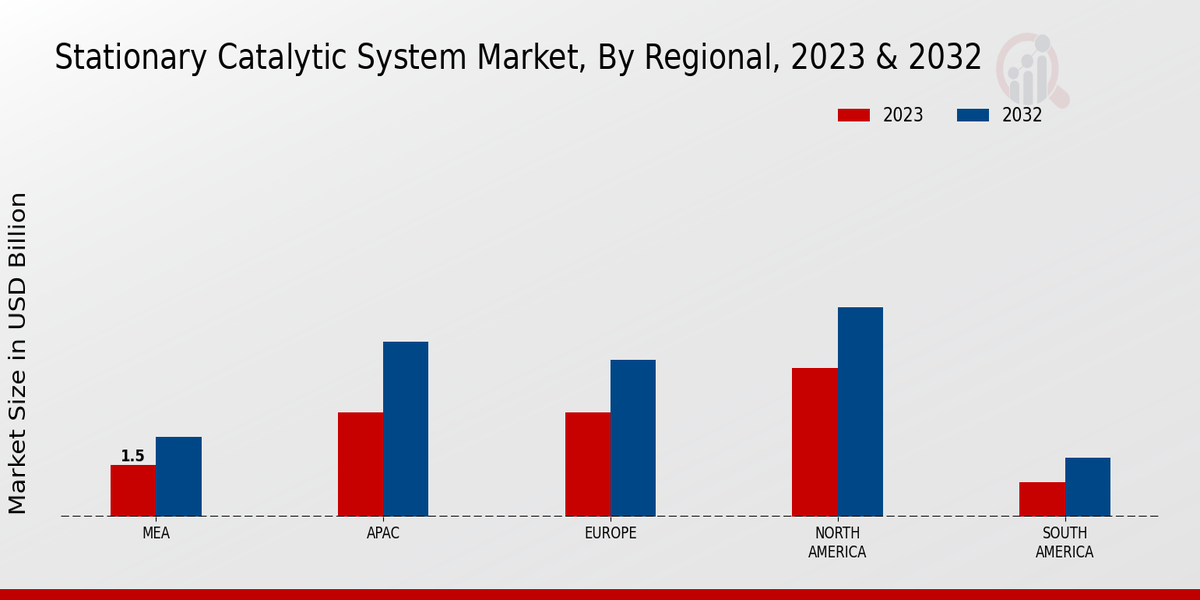Market Growth Projections
The Global Stationary Catalytic System Market Industry is poised for substantial growth, with projections indicating a market size of 13.8 USD Billion in 2024 and an anticipated increase to 21.8 USD Billion by 2035. This growth trajectory suggests a compound annual growth rate of 4.23% from 2025 to 2035, reflecting the increasing demand for efficient emissions control technologies across various sectors. The market's expansion is likely to be driven by regulatory pressures, technological advancements, and a growing emphasis on environmental sustainability.
Investment in Renewable Energy Sources
Investment in renewable energy sources is emerging as a key driver for the Global Stationary Catalytic System Market Industry. As nations transition towards sustainable energy solutions, there is an increasing need for efficient emissions control technologies in renewable energy facilities. For instance, biomass and biogas plants often require catalytic systems to manage emissions effectively. This trend is expected to foster market expansion, as the integration of renewable energy sources necessitates advanced catalytic solutions to ensure compliance with environmental standards. The market's growth is anticipated to align with the broader shift towards sustainable energy practices.
Rising Awareness of Air Quality Issues
Increasing awareness of air quality issues among the public and policymakers is a significant factor driving the Global Stationary Catalytic System Market Industry. As health concerns related to air pollution become more pronounced, there is a growing demand for solutions that can effectively reduce emissions from stationary sources. This heightened awareness is prompting governments to invest in cleaner technologies and incentivize industries to adopt catalytic systems. The market's growth trajectory is likely to be influenced by these societal shifts, as stakeholders prioritize air quality improvements and environmental sustainability.
Growing Industrialization and Urbanization
The ongoing trends of industrialization and urbanization are pivotal drivers of the Global Stationary Catalytic System Market Industry. As economies develop, there is a corresponding increase in energy consumption and emissions from industrial activities. Urban areas, characterized by high population density, contribute significantly to air pollution. Consequently, industries are compelled to implement stationary catalytic systems to mitigate emissions. This trend is expected to bolster market growth, with a compound annual growth rate of 4.23% projected from 2025 to 2035, as more sectors recognize the necessity of adopting cleaner technologies.
Technological Advancements in Catalytic Systems
Technological advancements play a crucial role in shaping the Global Stationary Catalytic System Market Industry. Innovations in catalyst materials and designs enhance the efficiency and effectiveness of catalytic systems. For example, the development of new catalytic converters that utilize advanced materials can significantly reduce harmful emissions. These advancements not only improve performance but also align with global sustainability goals. As industries adopt these cutting-edge technologies, the market is anticipated to grow, with projections indicating a rise to 21.8 USD Billion by 2035, reflecting the increasing reliance on sophisticated catalytic solutions.
Regulatory Compliance and Environmental Standards
The Global Stationary Catalytic System Market Industry is significantly influenced by stringent regulatory compliance and environmental standards. Governments worldwide are increasingly implementing regulations aimed at reducing emissions from stationary sources. For instance, the U.S. Environmental Protection Agency has established guidelines that necessitate the use of catalytic systems to control pollutants. This regulatory landscape is expected to drive the market, as industries seek to comply with these mandates. The market is projected to reach 13.8 USD Billion in 2024, indicating a robust demand for advanced catalytic technologies that meet these environmental requirements.






















Leave a Comment